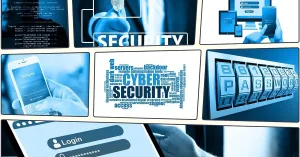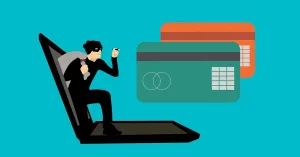In the past year, we’ve seen some revolutionary changes in technology. Artificial intelligence (AI) is now a part of daily life, the Internet of Things (IoT) grows larger by the day, big data is used by businesses of all sizes, 5G subscriptions are rising, and computers, laptops, and smartphones continue to improve.
However, every technological breakthrough gives rise to those who seek to use them for criminal purposes. With the ever-changing nature of cyber attacks, organizations, businesses, and individuals need to remain vigilant in 2024 more than ever before.
To keep you up to date and ready to defend against these threats, in this article, we’ll explore the latest trends in cybersecurity. As well as taking a look at emerging cyber threats, we’ll discuss the best security measures you can employ to protect yourself and others in 2024, such as identifying fraud with Money Thumb's thumbprint fraud detection tool.
Emerging and Evolving Cyber Threats
First, let’s take a look at the newest threats to cybersecurity. Since cyberattacks evolve to overstep the latest cybersecurity measures, you may well have heard about many of these threats before. However, it’s vital to understand the nuances of these potential attacks so you can adjust your cybersecurity measures accordingly.
Automotive Hacking
Modern cars, especially electric cars, run on software that controls everything from the radio to the airbags. Also known as cyber-carjacking, automotive hacking takes advantage of vulnerabilities in this software.
According to a report by Upstream, in 2022, automotive hacking increased by 380%. But it’s not just the cars themselves that are at risk. Electric charging points can be accessed remotely by hackers, who can slow them down or stop them from working entirely.
Once a hacker has accessed a vehicle, they can do several things. These include listening in through microphones to gain sensitive data or installing ransomware that demands payment before the car can work normally. By 2024, the industry is expected to lose $505 billion to these attacks.
However, defending against automotive hacking isn’t easy. With so many electronic control units (ECUs), sensors, and components, hackers can take advantage of numerous entry points. To add to this, developing patches and rolling out software updates takes a significant amount of time.
AI-powered Threats
There are a variety of ways that AI can be used by cybercriminals, such as:
Automated Attacks: Data mining, finding vulnerabilities, and launching attacks can all be automated with the help of AI.
Deepfakes: AI-generated audio, video, or text content is used to impersonate individuals in social engineering scams.
Adversarial Machine Learning: AI is commonly used to recognize and defend against cyber threats. Adversarial machine learning techniques can deceive these AI-powered security tools.
Data Poisoning: Training data for AI security systems can be compromised to introduce biases and increase the likelihood of incorrect decisions.
Again, defending against these attacks is difficult because protection relies on finding and fixing vulnerabilities in existing AI security systems.
Cryptocurrency Attacks
In 2023, cryptocurrency continued to gain popularity, with many new coins made available for purchase. From hacking wallets to creating scam coins and making off with the proceeds, cybercriminals use this popularity to their advantage.
According to many advocates of cryptocurrency, its unregulated nature is one of its biggest benefits. However, this is also one of its weaknesses. There are no organizations to seek help from when crypto-based cyberattacks happen. In particular, cybercriminals using ransomware often ask for payments to be made in cryptocurrency. This is because the funds cannot be tracked.
Statistics published by Reuters show that this practice is only becoming more common. In the first quarter of 2022, there were $175.8 million worth of ransomware payments made in Bitcoin. In the same period in 2023, this number reached $449.1 million. In 2024, we can only expect this number to increase once again.
Third-Party Breaches
Outsourcing work has become very popular for businesses of all sizes. It allows businesses to cut costs on office space and salaries, and increase flexibility. Korn Ferry found that about 40% of businesses now outsource their hiring processes to external HR organizations. To add to this, Fiverr shared that, in 2022, 78% of businesses were more likely to hire freelancers than employees.
While this does have advantages, it also opens the door for potential malicious figures. Third-party attacks occur when cybercriminals use suppliers, services, or anyone with connections to their target to gain access to their systems. This may be through vulnerabilities in third-party ISMS, software or authentication protocols, or weaknesses in a supply chain.
IoT Device Hacking
The Internet of Things refers to the growing number of household devices that can connect to the Internet, the cloud, and each other. Google Home and Amazon Alexa are part of the IoT, as well as lights, thermostats, speakers, smart TVs, refrigerators, dishwashers, gym equipment, and much more.
Cybercriminals use these devices to gain access to your network. But, according to Michelle Kradolfer, an IoT expert at Secured by Design, “The adoption of cyber security requirements within these products is poor - only 1 in 5 manufacturers embed basic security requirements in consumer connectable products, although consumers overwhelmingly assume these products are secure.”
As the IoT continues to grow and connect with 5G networks, so do the opportunities for your cybersecurity to be compromised. Hackers may steal your data, capture audio or video footage from inside your home, or add the device to a botnet in preparation for a Denial of Service (DoS) attack.
Bear in mind that simply because these threats are becoming more common, does not mean hackers and scammers have ceased to use other, older tactics to facilitate attacks. If you want to know what to look out for, you can check out our post on spotting and stopping certain cyber threats here.
Cybersecurity Best Practices for 2024
Now that you know about the newest threats to watch out for in 2024, let’s take a look at how you can add to your existing cybersecurity to protect against them.
- Beat the New with the Old - While you wait for automotive manufacturers to release patches, seemingly outdated measures still provide protection. For example, a steering wheel lock, a branded mechanic, and a car with manual door locking systems can prevent some attacks and mitigate their results. Additionally, wrapping your key fob in foil and putting it in the fridge blocks its signal and stops hacks.
- Improve Basic Cyber Hygiene - Be sure to change the password to your internet regularly. The same goes for your car’s network and any apps that control your thermostats and heating systems, lighting, TV, or speakers. Never reuse the same password twice, be this on two different accounts or when changing passwords. Store passwords offline or in an encrypted password manager to keep track. Finally, always log out of accounts shut down hardware when you’re not using them, and delete accounts that you no longer use.
- Due Diligence - If you run a business that outsources tasks or works with several suppliers, it’s vital you do your due diligence and ensure their cybersecurity practices are up to scratch. Don’t shy away from requesting reports or conducting cybersecurity audits, and always be explicit in your requirements.
- Multi-Factor Authentication (MFA) - Usernames and passwords are no longer enough to ensure cybersecurity. MFA requires another form of verification and ensures that no one but you or other trusted individuals can log into accounts on your network. Always enable MFA on your accounts where possible.
- Identity and Access Management (IAM) Measures - With the rise of remote working, employees may need to access sensitive data on their networks. VPNs and encrypted devices are ways to secure this process, but IAM measures can take it a step further. Essentially, IAM checks logins against a secure database of individuals who are permitted access to your systems, then grants them only the level of clearance you have afforded them. For businesses and organizations, combining MFA with IAM provides a robust security framework even where remote and hybrid working are concerned.
- Zero Trust Security - A relatively recent security model that is becoming more common is Zero Trust Security. It works in tandem with MFA and IAM and works on the principle that no one should be automatically granted access to your systems. Following this model means continually checking and verifying employees and third parties who have access to your systems, and thoroughly investigating any anomalies.
- Consolidate Licenses - Your security software, such as ad-blockers, antivirus, anti-spyware, VPN, firewall, and intrusion detection and prevention systems should ideally be handled by as few companies as possible. This ensures that you can keep on top of software updates and patch releases, and install new security measures accordingly. Software License Management tools can help you with this.
- The Human Element - While automated cybersecurity systems are becoming the new norm, these can still be vulnerable. On the other hand, leaving cybersecurity entirely up to humans means mistakes can, and likely will, be made. A combination of AI-powered, automated threat detection systems subject to daily or weekly checks by cybersecurity professionals is best.
- Keep Up to Date - As we go into 2024, be sure to keep up to date with news of recent cyberattacks and new cybersecurity measures. As mentioned, knowing what threats you may be up against can help you choose the right cybersecurity measures and implement them early. A proactive approach to your cybersecurity helps find and fix vulnerabilities and keeps you safe in the digital age.
In Conclusion…
Cybersecurity threats are only going to become more advanced in 2024. Technological breakthroughs like AI and factors such as remote working have changed the landscape of digital security.
Emerging trends in cyberattacks include automotive and IoT hacking, a growing number of third-party breaches, using AI against automated security systems, and ransomware that demands payment in untraceable cryptocurrencies. However, that doesn’t mean there aren’t ways to defend against these threats.
In 2024, basic cybersecurity such as password management, keeping devices up to date, and avoiding unsecured networks and sites will be just as important as ever. On top of this, recent measures such as Zero-Trust models, IAM protocols, and cybersecurity audits will be essential for businesses and organizations.
Cybersecurity is an ongoing battle, so prepare yourself by learning about threats and seeking expert advice. By remaining proactive, and consistently checking and refreshing your cybersecurity measures, you can navigate the digital realm with confidence.
Sources
- https://www.simplilearn.com/top-cybersecurity-trends-article
- https://www.embroker.com/blog/top-cybersecurity-threats/
- https://upstream.auto/reports/global-automotive-cybersecurity-report/
- https://www.forbes.com/sites/stevetengler/2023/10/25/new-auto-cyber-study-reveals-threat-intelligence--or-lack-thereof/#
- https://www.ncsc.gov.uk/collection/annual-review-2023/technology/case-study-cyber-security-ai
- https://www.forbes.com/sites/forbestechcouncil/2023/06/23/ai-and-cybercrime-unleash-a-new-era-of-menacing-threats/
- https://www.reuters.com/technology/crypto-ransom-attacks-rise-first-half-2023-chainalysis-2023-07-12/
- https://www.investopedia.com/articles/investing/032615/can-bitcoin-be-hacked.asp/
- https://hbr.org/2019/05/your-approach-to-hiring-is-all-wrong
- https://www.fiverr.com/news/fiverr-business-data-aug-2022
- https://www.securedbydesign.com/about-us/news/are-you-ready-for-april-2024
- https://www.byos.io/blog/iot-attacks/
- https://sprinto.com/blog/best-cybersecurity-practices/
- https://eu.usatoday.com/story/tech/columnist/komando/2023/04/06/how-keep-hackers-taking-control-your-car/11594806002/
- https://support.microsoft.com/en-us/topic/what-is-multifactor-authentication-e5e39437-121c-be60-d123-eda06bddf661
- https://www.microsoft.com/en-gb/security/business/security-101/what-is-identity-access-management-iam/
- https://www.asrcfederal.com/securing-the-digital-frontier-understanding-the-pillars-of-zero-trust/





















Add comment